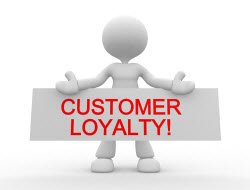Loyalty programs are an ideal way to maximize the Return on Investment (ROA) of marketing efforts as they are targeted for retention of the most loyal and most profitable customers as well as creating more advocates from the pool of existing customers. We all know that it costs more money to attract new customers than it does to get an existing customer in the store – most studies claim it’s at least 5 times as expensive to attract a new customer. We also know that sales to existing customers tend to be larger than sales to new customers (according to BIA/Kelsey, repeat customer sales are 67% higher). The focus of a well-designed Loyalty plan is improving customer retention; the challenge is to assure that the gain in profitability and customer service more than covers the cost of the rewards provided.
Considerations when Developing a Plan
The first priority of a Loyalty Plan is a proper design targeted toward your customers’ needs. It needs to reward loyal customers without giving away the store but also needs to be attractive to the less frequent shoppers in hopes of moving them up the loyalty ladder. It can even help provide incentive for sale shoppers to become regular price shoppers.
A good plan must provide the flexibility to be changed as needed to retain the profitability of the plan. Yet, any change, even those that favor the consumer, will always be perceived as a “loss” to the pessimistic or promiscuous customer. Remember, it is always easier to increase than decrease rewards if the current plan isn’t yet profitable, but it is just as important to retain the right to modify a plan as needed. It would be great if there was a single answer to how much reward is enough to work and not too much to be profitable, but like most marketing, the answer lies in testing it. One solution is to start with limited time only incentive plans before a more “permanent” loyalty plan is committed to.It is an important incentive to customers if you communicate the point balance to your customers; in fact, the whole point of a rewards program is to build incentive for customers to spend more. While “silent plans” (those where points are not displayed or printed at the point of sale) can have their place, they miss the benefit that some customers are points collectors and will purchase more to earn rewards. How will you communicate the reward program to your customers? Effective loyalty plans should have their own promotional budgets. Again, complex rules and restrictions should be avoided; keeping it simple and easy to understand is the best way to excite customers.
While the simplest plans will be the easiest to communicate to customers, there are important considerations when developing a plan to fine tune it for optimal performance.
- Will the reward be a percentage discount, a dollar award, or a free item?
- What sales qualify for earning points? Is it limited by type of merchandise, store group, or even vendor?
- What happens when less than the full amount of an award is redeemed? Are surplus points retained or lost?
- Are points earned on markdowns, discounts, or when Loyalty Plan awards are redeemed?
- Is the plan designed to be permanent or promotional? Traffic can be increased with plans that reward customers at a time later than when points are earned.
- How will returns be handled? If award discounts are netted in returns (and they should be), are points restored to the account? And when are restored points expired?
- What if anything will be printed on the Sales Receipt? Their current point balance? The numbers of Points till the next award? When an award is available? When points are soon to expire?
Each of these questions should be answered when establishing a plan. If not clear to customers, at least everyone on the sale floor should know the answers to these questions when asked by customers.
Example Plans
While every plan really is customized for each store, the following are examples to provide an idea of the range of possibilities:
- Basic Dollar Awards
- Basic Percentage Off Awards
- Buy X, get 1 Free (great for focused items such as cosmetics or shirt clubs)
- Buy X, get a Percentage Off
- Retained Percentage Plans, with or without increment accelerators
- Unused Savings Awards such as spend $X on clothing and receive $X in free alterations.
- Buy now and save later plans are a great incentive to build traffic or reward in-season shopping with sale event discounts
- Silent Plans allow for flexible and personal awards instead of published plans.
- Cooperative promotions such as Gift awards for another reciprocating business, such as a local restaurant.
Measuring Success
As with all marketing investments, the retailer must be able to accurately measure the results. Is it working and profitable? With the right software, this is easy to measure.
Just improving the retention rate of your most loyal customers can be a significant factor in profitability. Assume that you are now retaining 70% of your best customers each year (70% of your top customers last year are still your top customers this year). In five years, starting with 1000 best customers you will only have 168 of your original best customers; if the retention rate can be increased to 90%, you will retain 3.5 times as many customers (590 customers) – even improving the retention rate by 5% increases the number of good customers retained by 40% in just five years. If you consider the life time value of your best customers, focusing on improving customer retention of even your best customers is critical. It is an easy number to identify (see sidebar), and would be important to know for the past several years before adding a loyalty plan.

